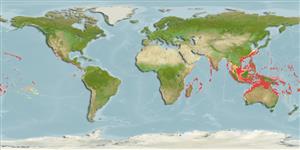>
Eupercaria/misc (Various families in series Eupercaria) >
Labridae (Wrasses) > Bodianinae
Etymology: Bodianus: Bodianus after Bodiano or Pudiano, from the Portuguese pudor, meaning modesty (Jordan & Evermann, 1896); bilunulatus: Name formed from the Latin adverb bis, for twice and Latin diminutive noun lunula (luna + ulus) for 'somewhat like the moon'; apparently referring to the lunate caudal fin (double emarginate with filamentous lobes) of the type specimen (Ref. 75973).
More on author: Lacepède.
Environment: milieu / climate zone / depth range / distribution range
Ecologia
marinhas associadas(os) a recifes; intervalo de profundidade 3 - 160 m (Ref. 9823). Tropical; 30°N - 30°S, 30°E - 134°W
Indo-West Pacific: east coast of Africa to Japan, the Philippines and New Caledonia.
Tamanho / Peso / Idade
Maturity: Lm ? range ? - ? cm
Max length : 55.0 cm TL macho/indeterminado; (Ref. 4392); peso máx. publicado: 1.8 kg (Ref. 4887)
Espinhos dorsais (total) : 12; Raios dorsais (total) : 10; Espinhos anais: 3; Raios anais : 12. Young easily identified by the unusual coloration. Adults normally have an oval shaped black saddle near the tail, but it may become indistinct in large males (Ref. 48636).
Adults occur on deep reef slopes rich with invertebrates such as sponges and seawhips, but young adults are occasionally seen much shallower (Ref. 48636). Usually solitary in coral and rocky reefs. Feed mainly on benthic, hard-shelled, invertebrates such as mollusks and crustaceans. Protogynous (Ref. 55080). Oviparous, distinct pairing during breeding (Ref. 205).
Ciclo de vida ou comportamento de acasalamento
Maturidade | Reprodução | Desova | Ovos | Fecundidade | Larvas
Oviparous, distinct pairing during breeding (Ref. 205). Size at sex change: 38.6-40.5 cm L (Ref. 55080).
Westneat, M.W., 2001. Labridae. Wrasses, hogfishes, razorfishes, corises, tuskfishes. p. 3381-3467. In K.E. Carpenter and V. Niem (eds.) FAO species identification guide for fishery purposes. The living marine resources of the Western Central Pacific. Vol. 6. Bony fishes part 4 (Labridae to Latimeriidae), estuarine crocodiles. FAO, Rome. (Ref. 9823)
Status na Lista Vermelha da UICN (Ref. 130435: Version 2024-1)
Uso pelos humanos
Pescarias: pouco comercial; peixe esportivo: sim; Aquário: Espécies comerciais
Ferramentas
Relatórios especiais
Baixar XML
Fontes da internet
Estimates based on models
Preferred temperature (Ref.
123201): 23.6 - 28.8, mean 27.4 °C (based on 932 cells).
Índice de diversidade filogenética (Ref.
82804): PD
50 = 0.5000 [Uniqueness, from 0.5 = low to 2.0 = high].
Bayesian length-weight: a=0.01230 (0.00569 - 0.02662), b=3.05 (2.87 - 3.23), in cm total length, based on LWR estimates for this Genus-body shape (Ref.
93245).
Nível Trófico (Ref.
69278): 3.4 ±0.49 se; based on food items.
Resiliência (Ref.
120179): Baixo, tempo mínimo de duplicação da população 4,5 - 14 anos (Preliminary K or Fecundity.).
Fishing Vulnerability (Ref.
59153): Moderate vulnerability (42 of 100).
Nutrients (Ref.
124155): Calcium = 33.5 [19.8, 51.9] mg/100g; Iron = 0.511 [0.303, 0.904] mg/100g; Protein = 18.5 [15.6, 20.7] %; Omega3 = 0.143 [0.098, 0.211] g/100g; Selenium = 44 [27, 72] μg/100g; VitaminA = 82.7 [26.3, 281.8] μg/100g; Zinc = 1.19 [0.88, 1.84] mg/100g (wet weight);
